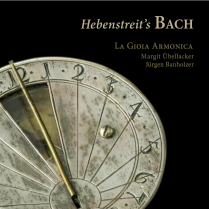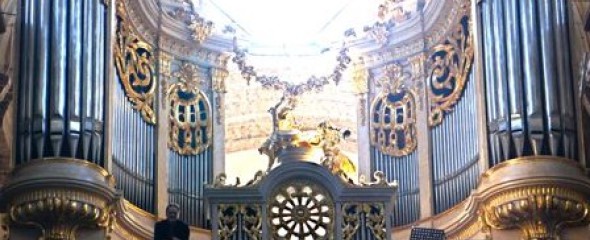"The organ in the church of St. Cosmae et Damiani in Stade, built in 1668-1675 by Berendt Hus and Arp Schnitger, is the ideal instrument for this purpose. Banholzer makes full use of the possibilities of this magnificent instrument and proves himself here to be an interpreter faithful to the style."
(Johan van Veen, Toccata 03/2022, on the CD "O güldenes Licht")
"Banholzer is excellent in the accompaniment and in the solo pieces. I would strongly recommend this CD to anyone interested in this period of music history, for the sake of the interpretation and of the repertoire."
(Johan van Veen, Toccata 03/2022, über die CD "Il Pesarino")
"Jürgen Banholzer, with his confident and brilliant playing, demonstrates without difficulty the indisputable superiority of the harpsichord in terms of counterpoint and the complexity of the textures is dazzling."
(Viet-Linh Nguyen, MUSE BAROQUE, 9.1.2022)
„Jürgen Banholzer is the perfect partner at the keyboard, and he also delivers outstanding performances of the keyboard pieces."
(Jan van Veen, MusicWeb International 2022)
"Banholzer fascinated the audience with his highly virtuosic harpsichord playing. He let his fingers dance over the entire keyboard of the harpsichord with breathtaking speed. ... Banholzer proved his skills once again in performing Handel's Suite No. 5 in E major from the Suites de Pièces pour le clavecin."
(Carmen Diemer-Stachel, Walldorfer Rundschau, 10.10.2022)
„Jürgen Banholzer is an excellent accompanist and contributes some fine solo pieces, which take full advantage of the fact that here two Italian instruments are used: the copy of a Grimaldi harpsichord of 1697 and a historical organ by Vincenzo Colombi (1532/33)“
(Johan van Veen, musica Dei donum, 31.1.2022)
"[being an] expert accompanist in the style [Jürgen Banholzer] rendered some contemporary toccatas on the ancient organ of Valvasone cathedral which gleam like a gilt frame."
(Bernd Feuchtner, Fono Forum Mai 2021)
"Jürgen Banholzer accompanies [the singer Matthias Lucht] with a never-ceasing
richness of imagination"
(Concerto – Das Magazin für Alte Musik, Nr. 292, Juy/August 2020)
"My special praise goes - next to Karola Pavone as Despina - to the harpsichordist of the show because he accompanied so wonderfully the hilariously many recits. ... He just again and again accompanied imaginatively, with lots of wit and lots of esprit: it was reallly so much fun to listen to and it rendered yet another layer of meaning to the stage characters."
(Meinolf Bunsmann, Hessischer Rundfunk, 27.3.2015)
COSI FAN TUTTE
opera by Wolfgang Amadeus Mozart
premiere April 25th 2017
Philharmonisches Orchester Gießen
harpsichord: Jürgen Banholzer
conductor: Michael Hofstetter
hr2_fruehkritik_Cosi fan tutte.mp3
MP3-Audiodatei [6.8 MB]
"Next in the programme is the harpsichord concerto No. 1 in d minor BWV 1052 and Jürgen Banholzer at the keyboard. ... Special applause for this highly enjoyable and virtuosic performance."
(Brigitte Gaiser, Taunus Zeitung, 8.3.2017)
"The organ can indeed sound different, as demonstrated by Jürgen Banholzer. ... Banholzer’s great skill came to the fore in the chamber music. Be it as an accompanist or soloist, this musician is ideally suited to the musical aesthetic of subtle and refined sounds. He turns the lack of pedals into a virtue of intimate listening."
(Hans-Jörg Loskill, Der Westen, January 2011)
"As an expert on baroque organs, he switched off the electric bellows and had the air pumped into the organ by a calcant. By doing so he achieved a much more vivid tone, which lent more warmth to the sound of the organ [by Franz Xaver Christoph, 1776] . ... All entire virtuosic mastery he then showed in C.P.E Bach’s Sonata in F major. Sparkling arpeggios, soft and delicate runs, energetic and vigorous echo-effects – everything was there."
(Peter Bubenik, Niederösterreichische Nachrichten, 12.7.2011)
"Jürgen Banholzer proved an astute listener and a virtuoso soloist ... ."
(Martina Holbein, Schwarzwälder Bote, 13.8.2007)
"Under his hands Martini’s polyphonic structures proved fresh and spontaneous, as did Mozart’s playful fantasy."
(Susanne Eckstein, Pfullinger Stadtanzeiger, 24.7.2006)

